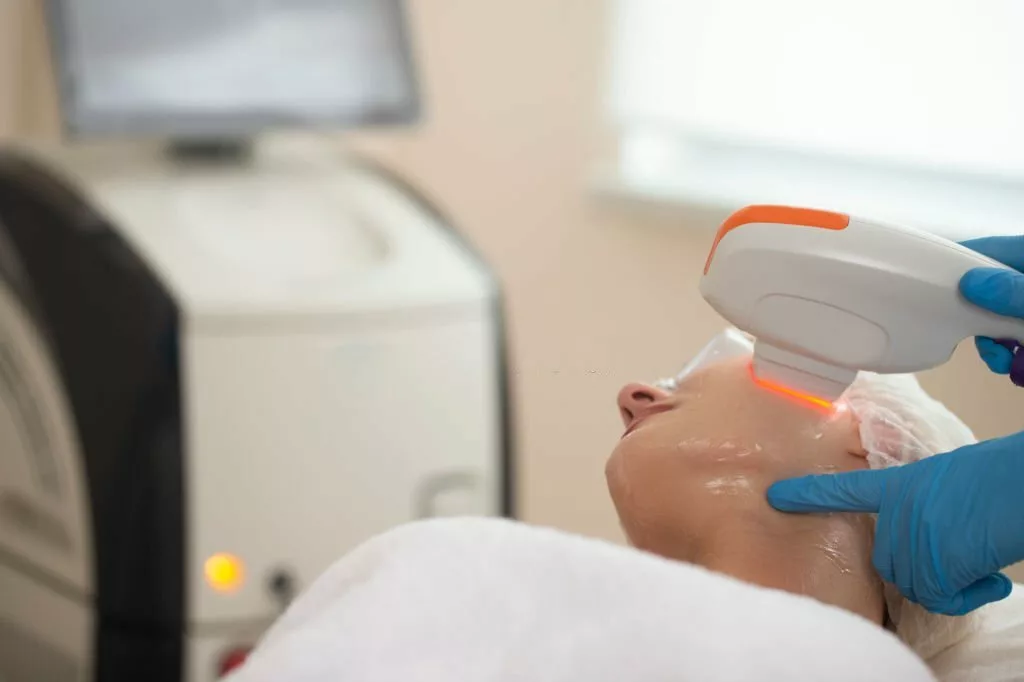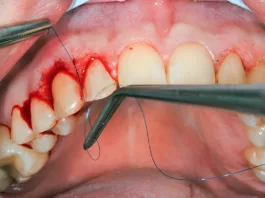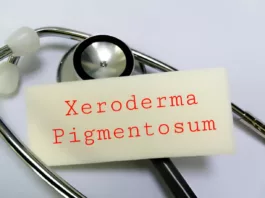What is Photorejuvenation?
Photorejuvenation, also commonly known as photofacial or phototherapy, is a non-invasive cosmetic procedure that uses light-based technology to rejuvenate the skin and address various skin concerns. It involves the use of intense pulsed light (IPL) or laser devices to target specific skin issues such as sun damage, age spots, fine lines, wrinkles, acne scars, and uneven skin tone. Light from IPL (Intense Pulsed Light) devices typically falls within the visible to near-infrared spectrum, ranging from 400 to 1200 nm. This wide range of light makes IPL devices versatile, enabling them to treat both blood vessels and pigmentation issues in the skin. Hence, photorejuvenation is a safe and effective way to achieve youthful skin without surgery.1Bolognia, J. L., & Schaffer, J. V. (2023). Principles of laser and intense pulsed light for cutaneous lesions. In UpToDate. Retrieved June 26, 2024, from https://www.uptodate.com/contents/principles-of-laser-and-intense-pulsed-light-for-cutaneous-lesions?search=photorejuvenation&source=search_result&selectedTitle=1%7E4&usage_type=default&display_rank=1

How Photorejuvenation Works?
During the photorejuvenation treatment, intense pulses of light are emitted onto the skin, penetrating the deeper layers without damaging the surface. The light energy is absorbed by pigmented areas or blood vessels, causing them to heat up and break down. This process stimulates the body’s natural healing response, promoting collagen production and cellular renewal, resulting in smoother, more youthful-looking skin. Photorejuvenation operates on light energy to stimulate the synthesis of collagen. The specific mechanism varies according to the type of light, but the general mechanism of action is described below.
Absorption of Light Energy
Skin is exposed to pulses or wavelengths of light energy. The light energy is absorbed by skin cells directly. Light hits the skin cells, melanin, and relevant targets.
Activation of Fibroblasts
Fibroblasts are special cells in the skin responsible for collagen production and related proteins. The light energy activates these fibroblasts, further initiating a series of biochemical reactions. It initiates the process of collagen production.
Collagen Production
The activated fibroblasts trigger collagen production. Collagen is the protein that maintains the structure, elasticity, and firmness of the skin. With age, our skin loses collagen and develops wrinkles or fine lines.
Skin Elasticity and Firmness
The increased collagen improves the skin’s elasticity. It reduces the appearance of wrinkles and fine lines.2Martella, A., & Raichi, M. (2017). Skin Photorejuvenation: An Update. Dermatology reports, 9(1), 7116. https://doi.org/10.4081/dr.2017.7116
The skin becomes firm, smooth, and more youthful in appearance.
It’s important to note that the specific wavelengths and energy levels used in photorejuvenation treatments can vary depending on the targeted skin concern. Different light energies penetrate the skin at different depths and target specific skin components.
Who should take Photorejuvenation?
Photorejuvenation treats a wide range of skin concerns. Due to the broad range of wavelengths, it can treat several different skin diseases and aesthetic problems.
You can think of photorejuvenation as a treatment option if you suffer from:3Martella A, Raichi M. Photoepilation and Skin Photorejuvenation: An Update. Dermatol Reports. 2017 Jun 13;9(1):7116. doi: 10.4081/dr.2017.7116. PMID: 28652906; PMCID: PMC5475414.
- Melasma
- Wrinkles
- Striae
- Acne scars
- Hyperpigmentation (dark spots)
- Spider veins
- Age spots
- Freckles (pin-sized brown spots)
Photorejuvenation Benefits
Let’s take a look at the benefits of photorejuvenation below.
Reduces Wrinkles and Fine Lines
Photorejuvenation gives a youthful look. Special light penetrates the skin and stimulates collagen and elastin production. It reduces the visibility of wrinkles and fine lines, thus making skin more youthful and firm.4Huang, A., Nguyen, J. K., Ho, D., & Jagdeo, J. (2020). Light Emitting Diode Phototherapy for Skin Aging. Journal of drugs in dermatology: JDD, 19(4), 359–364. https://doi.org/10.36849/JDD.2020.4711
Improvement of Skin Tone and Texture
Photorejuvenation also improves skin tone and texture. The light energy induces collagen production, thus reducing the bumps. The treatment helps to even the skin’s texture, making it single-tone and more refined.
Minimization of Sun Damage and Age Spots
Sun damage is a common concern for many individuals. It is presented as brown spots, freckles, and chronic melasma. Light energy effectively targets the excess melanin responsible for discoloration. With time, the skin becomes clear, resulting in a more youthful appearance.
Stimulation of Collagen Production
Collagen provides major structural support to the skin. As we age, collagen decreases, and skin eventually develops wrinkles and laxity. Photorejuvenation stimulates collagen production and restores the skin’s elasticity and firmness. It enhances the overall youthfulness and vitality of the skin.5Barikbin B, Akbari Z, Vafaee R, Razzaghi Z. The Efficacy of IPL in Periorbital Skin Rejuvenation: An Open-Label Study. J Lasers Med Sci. 2019 Fall;10(Suppl 1): S64-S67. doi: 10.15171/jlms.2019.S12. Epub 2019 Dec 1. PMID: 32021676; PMCID: PMC6983864.
Risks associated with Photorejuvenation
Although photorejuvenation is generally safe, it also has some mild risks.6Gade A, Vasile GF, Hohman MH, et al. Intense Pulsed Light (IPL) Therapy. [Updated 2024 Mar 1]. In: StatPearls [Internet]. Treasure Island (FL): StatPearls Publishing; 2024 Jan-. Available from: https://www.ncbi.nlm.nih.gov/books/NBK580525/
Redness and Swelling
After the procedure, some may experience temporary redness and swelling. Depending on the individual’s skin sensitivity, symptoms subside within a few hours or days.
Light Sensitivity
One may experience increased sensitivity to sunlight. It is essential to protect the treated skin from direct sun exposure. Use a physical barrier to avoid direct exposure, along with good sunblock. Sunscreen with high SPF minimizes the risk of sunburn and further skin damage. The ideal SPF is 30 or above.
Changes in Skin Color
One may experience temporary changes in skin color. This change is temporary and fades over time, but it is important to discuss it with a skincare professional if it happens.
Rare Complications
There is a mild risk of rare complications. These include blistering, scarring, or infection.
The severity of side effects varies according to skin type and sensitivity.
Photorejuvenation Treatment Process
A photorejuvenation treatment usually involves the following steps:
Consultation and Assessment
If you are interested in photo facials, consult your doctor. A dermatologist will assess your skin condition and determine if you are a suitable candidate for the treatment. They will then give detailed instructions on how to prepare for the procedure.
Preparation for the Treatment
Your skincare professional will provide specific guidelines tailored to your individual needs. Before the procedure, avoid excessive sun exposure and tanning beds. Additionally, certain medications, such as blood-thinning agents, may need to be temporarily discontinued to minimize the risk of complications.
Procedure & Application of Light-Based Technology
On the day of the treatment, the skin care professional will cleanse your skin and apply a cooling gel to enhance comfort during the procedure. They will then use a handheld device that emits light pulses into the targeted areas. The skin absorbs light energy, stimulating the desired rejuvenation effects.
Post-Treatment Care
It is essential to follow the post-treatment care instructions after every procedure. This mainly involves complete sun protection and the use of gentle skincare products. Redness and swelling are normal after photorejuvenation, but if they persist longer, it is better to consult your physician.
Photorejuvenation vs. Photofacial
Photorejuvenation and photofacial are terms often used interchangeably, but they have subtle differences. The former is a broad term encompassing various treatments to improve the skin’s appearance using light-based technologies, such as Intense Pulsed Light (IPL), lasers, and LED light therapies. These treatments target various skin issues, including sun damage, age spots, pigmentation, fine lines, wrinkles, enlarged pores, rosacea, and acne scars. Photorejuvenation’s overall effect is to promote collagen production, reduce pigmentation, and improve skin texture and tone.
On the other hand, photofacial is a specific type of photorejuvenation treatment that uses IPL technology. So, photorejuvenation is a broader term encompassing various light-based treatments for overall skin rejuvenation; a photo facial is a specific type of photorejuvenation treatment that specifically targets pigmentation irregularities and uneven skin tone. 7Trelles, M. A., Mordon, S., & Calderhead, R. G. (2007). Facial rejuvenation and light: our personal experience. Lasers in medical science, 22(2), 93–99. https://doi.org/10.1007/s10103-006-0418-6
Photorejuvenation vs. Dermaroller
Dermaroller is a minimally invasive device that is covered with tiny needles. These needles cause micro-injuries to the skin.
It stimulates the skin’s natural healing response, increasing collagen production and causing skin rejuvenation. Dermaroller is helpful in treating scars, wrinkles, and uneven skin texture.8Doddaballapur S. Microneedling with dermaroller. J Cutan Aesthet Surg. 2009 Jul;2(2):110-1. doi: 10.4103/0974-2077.58529. PMID: 20808602; PMCID: PMC2918341.
Photorejuvenation and derma roller treatments differ in their approaches to skin rejuvenation. Photorejuvenation primarily utilizes light-based technologies to target specific skin concerns, while derma rollers stimulate collagen production through controlled micro-injuries. The choice between the two treatments depends on individual preferences, skin conditions, and desired outcomes.
Take-Home Message
As we age, our skin loses collagen and lax down. Photorejuvenation has become popular due to its safety and youthful benefits. However, you must consult a skin care professional or dermatologist if you are interested in photorejuvenation treatment.
Care for your skin; be happy!
Refrences
- 1Bolognia, J. L., & Schaffer, J. V. (2023). Principles of laser and intense pulsed light for cutaneous lesions. In UpToDate. Retrieved June 26, 2024, from https://www.uptodate.com/contents/principles-of-laser-and-intense-pulsed-light-for-cutaneous-lesions?search=photorejuvenation&source=search_result&selectedTitle=1%7E4&usage_type=default&display_rank=1
- 2Martella, A., & Raichi, M. (2017). Skin Photorejuvenation: An Update. Dermatology reports, 9(1), 7116. https://doi.org/10.4081/dr.2017.7116
- 3Martella A, Raichi M. Photoepilation and Skin Photorejuvenation: An Update. Dermatol Reports. 2017 Jun 13;9(1):7116. doi: 10.4081/dr.2017.7116. PMID: 28652906; PMCID: PMC5475414.
- 4Huang, A., Nguyen, J. K., Ho, D., & Jagdeo, J. (2020). Light Emitting Diode Phototherapy for Skin Aging. Journal of drugs in dermatology: JDD, 19(4), 359–364. https://doi.org/10.36849/JDD.2020.4711
- 5Barikbin B, Akbari Z, Vafaee R, Razzaghi Z. The Efficacy of IPL in Periorbital Skin Rejuvenation: An Open-Label Study. J Lasers Med Sci. 2019 Fall;10(Suppl 1): S64-S67. doi: 10.15171/jlms.2019.S12. Epub 2019 Dec 1. PMID: 32021676; PMCID: PMC6983864.
- 6Gade A, Vasile GF, Hohman MH, et al. Intense Pulsed Light (IPL) Therapy. [Updated 2024 Mar 1]. In: StatPearls [Internet]. Treasure Island (FL): StatPearls Publishing; 2024 Jan-. Available from: https://www.ncbi.nlm.nih.gov/books/NBK580525/
- 7Trelles, M. A., Mordon, S., & Calderhead, R. G. (2007). Facial rejuvenation and light: our personal experience. Lasers in medical science, 22(2), 93–99. https://doi.org/10.1007/s10103-006-0418-6
- 8Doddaballapur S. Microneedling with dermaroller. J Cutan Aesthet Surg. 2009 Jul;2(2):110-1. doi: 10.4103/0974-2077.58529. PMID: 20808602; PMCID: PMC2918341.





